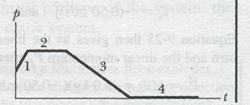
CATEGORIES:
BiologyChemistryConstructionCultureEcologyEconomyElectronicsFinanceGeographyHistoryInformaticsLawMathematicsMechanicsMedicineOtherPedagogyPhilosophyPhysicsPolicyPsychologySociologySportTourism
GRAVITATIONAL FIELD
Newton's law of gravitation can be restated in a useful way with the concept of gravitational field. Instead of calculating the interaction forces between two masses by using Eq. (6—11) directly, we consider a two-stage process. First, we think of one mass as creating a change at each point in the space surrounding it. This change is called a gravitational field. To describe it, we associate a vector quantity  with each point in space. The significance of
with each point in space. The significance of  is that a particle of mass m at a point where the gravitational field is
is that a particle of mass m at a point where the gravitational field is  experiences a gravitational force given by
experiences a gravitational force given by  . To measure a gravitational field we may place a small mass, called a test mass, at the point. If the mass experiences a gravitational force, then there is a gravitational field at that point.
. To measure a gravitational field we may place a small mass, called a test mass, at the point. If the mass experiences a gravitational force, then there is a gravitational field at that point.
In Example 6-8, instead of calculating directly the forces on the 0.001-kg body by the large bodies, we may take the point of view that the large bodies create a gravitational field at the location of the small body, and that the field exerts a force on any mass located at the point.
Because force is a vector quantity, gravitational field is also a vector quantity. We define the gravitational field  at a point as the quotient of the force
at a point as the quotient of the force  experienced by a test mass
experienced by a test mass  and the mass. Thus
and the mass. Thus
 (6-17)
(6-17)
To say it another way: At a point where the gravitational field is  , the force
, the force  on a mass
on a mass  is given by
is given by
 (6-18)
(6-18)
The gravitational field due to a point mass  , at a distance
, at a distance  away from it, has magnitude
away from it, has magnitude
 (6-19)
(6-19)
and is directed toward the point mass. Gravitational fields also obey the principle of superposition: The total gravitational field at a point, due to several point masses, is the vector sum of the gravitational fields of the separate masses. Gravitational field is a very useful concept; when we know the field, we can calculate quickly the gravitational force on any body.
The gravitational field in the vicinity of any collection of masses varies from one point to another in the region. Thus it is not a single vector quantity but rather a whole collection of vector quantities, one vector associated with each point in space. Indeed, this is what is meant by the general term vector field. Another familiar example of a vector field is the velocity in a flowing fluid: different parts of the fluid have different velocities, and so we speak of the velocity field in the fluid. During our study of electricity and magnetism, we will discuss in detail the properties of the electric and magnetic fields; both of these are vector fields.
Linear Momentum
Momentum is a word that has several meanings in everyday language but only a single precise meaning in physics. The linear momentum of a particle is a vector  defined as
defined as

in which  is the mass of the particle and
is the mass of the particle and  is its velocity. (The adjective linear is often dropped, but it serves to distinguish
is its velocity. (The adjective linear is often dropped, but it serves to distinguish  from angular momentum, which is associated with rotation.) Since
from angular momentum, which is associated with rotation.) Since  is always a positive scalar quantity, Eq. 9-22 tells us that
is always a positive scalar quantity, Eq. 9-22 tells us that  and
and  have the same direction. From Eq. 9-22, the SI unit for momentum is the kilogram-meter per second.
have the same direction. From Eq. 9-22, the SI unit for momentum is the kilogram-meter per second.
Newton actually expressed his second law of motion in terms of momentum:
The time rate of change of the momentum of a particle is equal to the net force acting on the particle and is in the direction of that force.
In equation form this becomes
 (9-23)
(9-23)
Substituting for  from Eq. 9-22 gives
from Eq. 9-22 gives

Thus, the relations  and
and  are equivalent expressions of Newton's second law of motion for a particle. Thus, the relations
are equivalent expressions of Newton's second law of motion for a particle. Thus, the relations  and
and  are equivalent expressions of Newton's second law of motion for a particle.
are equivalent expressions of Newton's second law of motion for a particle.

|
•Checkpoint 3: The figure gives the linear momentum versus time for a particle moving along an axis. A force directed along the axis acts on the particle, (a) Rank the four regions indicated according to the magnitude of the force, greatest first, (b) In which region is the particle slowing?
Date: 2015-01-12; view: 1430
| <== previous page | | | next page ==> |
| MASS AND WEIGHT | | | The Linear Momentum of a System of Particles |